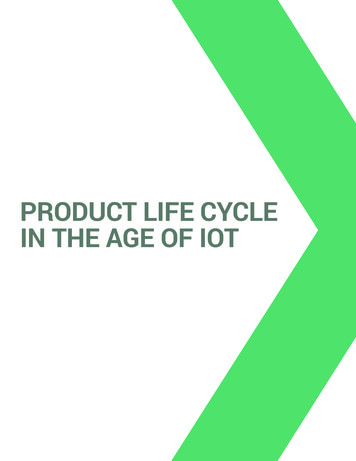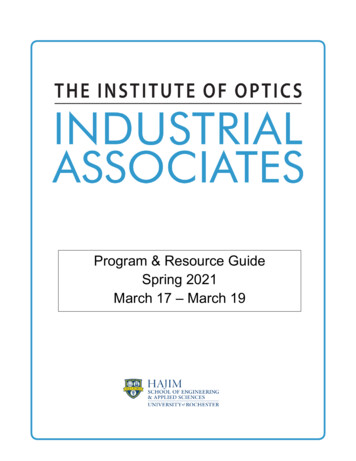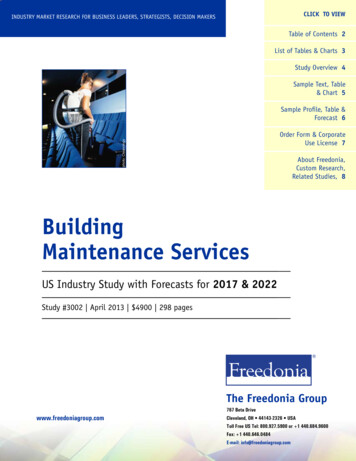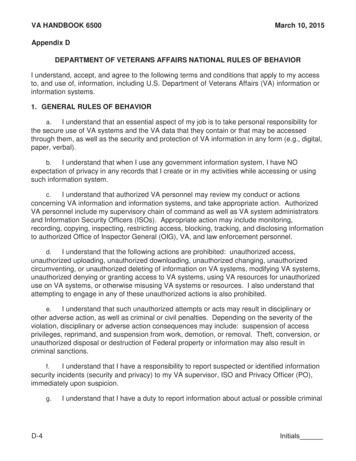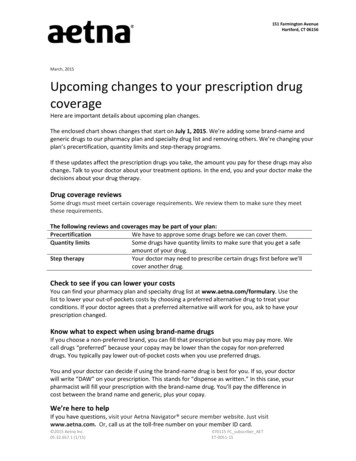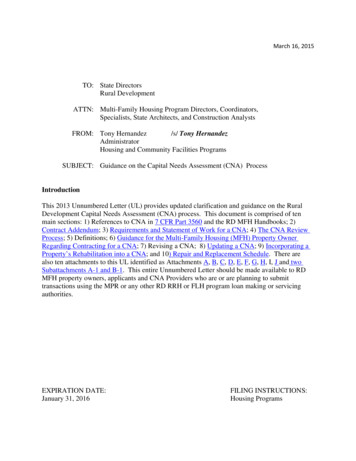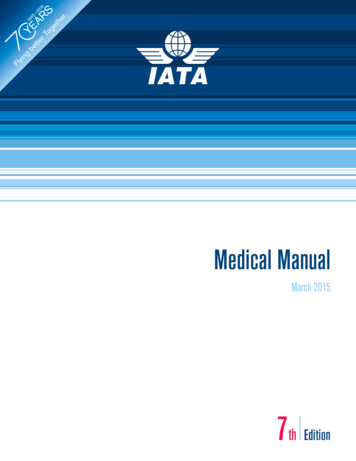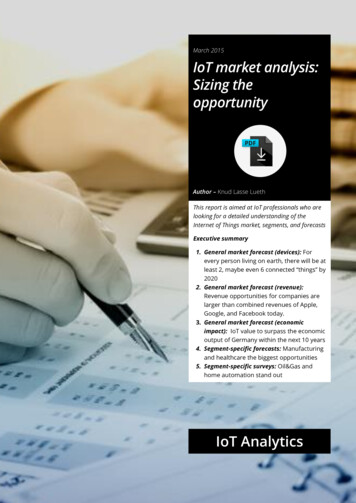
Transcription
March 2015IoT market analysis:Sizing theopportunityAuthor – Knud Lasse LuethThis report is aimed at IoT professionals who arelooking for a detailed understanding of theInternet of Things market, segments, and forecastsExecutive summary1. General market forecast (devices): Forevery person living on earth, there will be atleast 2, maybe even 6 connected “things” by20202. General market forecast (revenue):Revenue opportunities for companies arelarger than combined revenues of Apple,Google, and Facebook today.3. General market forecast (economicimpact): IoT value to surpass the economicoutput of Germany within the next 10 years4. Segment-specific forecasts: Manufacturingand healthcare the biggest opportunities5. Segment-specific surveys: Oil&Gas andhome automation stand outIoT AnalyticsPage 0
March 2015IoT market analysis: Sizing theopportunityThe starting point of market analysis is usually a sound understanding ofgeneral market parameters like market size, segments, and forecasts.The Internet of Things is such a fresh phenomenon, however, and it hassuch strong dynamics that there is a lack of sound and proven marketanalyses.This whitepaper summarizes the major IoT-related market forecasts andmarket segmentations that exist today, visualizes them in acomprehenisve way, and interprets the data.1. General market forecasts (devices)“50 billion devices will be connected by2020”Cisco’s prediction for the Internet ofThingsTwo technology companies have published data around the IoT marketpotential in connected devices: Cisco and Ericsson. Both foresee around50 billion connected devices by 2020. In addition, the global andestablished research companies Gartner, IHS Global Insight, ABIresearch and IDC as well as the specialized IoT research firm HarborResearch have developed their own forecasts.Figure 1: Market forecasts for connected devices 2014-2020Today we have roughly between 6 and 14 billion autonomous connecteddevices or “Things” that are connected via some form of communication.These figures do not include smartphones, tablets, computers, andsimilar. The exact definitions of the research companies vary slightly.Page 1
In general, what forecasters agree on: Strong growth. We will see a massive increase in connecteddevices in the next years. The expected growth rates are wellbeyond those of most other industries that are being forecasted(Annual growth rates ranging from 14% to 29%). For everyperson living on earth, there will be at least 2, maybe even 6connected “things” by 2020. More things than smartphones. “Things” will clearly be themajority of all connected devices by 2020. Today the number ofconnected devices that are not “Things” (i.e. smartphones,computers, tablets, etc.) is almost equal to the number ofconnected things. (e.g., ABI says there are 7 billion smartphones,PCs and similar today). “Things” are expected to outgrowsmartphones, computers, and the like by a landslide.Annual growth rates for connecteddevices between 14% and 29%Up to 6 connected devices for everyperson on earth by 2020Where forecasters diverge: Absolute numbers. The number of connected devices by 2020.The low estimate is 18 billion connected devices, the mostbullish forecast states 50 billion devices. That is a massivedifference of 275% from the point of view of the lowest forecast.One should note that both Cisco and Ericsson, which provide thehighest estimate, have a direct interest to attain this number.Both are selling solutions in the IoT field and are betting on thisindustry. Therefore it is questionable how “objective” theirforecasts are.The research companies have taken a traditional top-down modellingapproach to evaluating these markets. Gartner for example describestheir methodology by saying they triangulated their forecast using threedifferent approaches: A Long-Tail Product Category Analysis, a numberper-population study, and an economic envelope analysis.Cisco, however has taken a different approach. The company quantifiedthe industry completely bottom-up. Cisco analyzed 50 use cases for IoTin the private sector, calculated these individually and thenapproximated their potential in case of a world-wide roll-out.Page 2
2. General market forecasts (revenues)Five companies have estimated how much revenue will be generatedfrom companies that are active in the IoT industry: IDC, Visiongain,Harbor Research, Markets&Markets, and Gartner.Figure 2: Market forecasts for revenues from connected devices 2014-2020In general, what forecasters agree on: Strong revenue growth. We will see a massive increase in IoTgenerated revenue in the next years with double-digit growth.Where forecasters diverge: The starting point today. While Markets&Markets reports 129Billion of revenues in 2014, IDC already reports that it is a 2.3Trillion industry. That is an incredible difference of 1760%from the point of view of Markets&Markets. Clearly thedefinition of “Internet of things”-industry varies significantly. Where markets are headed. While Gartner is talking about a 300Billion industry in 2020, IDC believes in a 7 trillion industry.Page 3
3. General market forecasts (economicimpact)Cisco, GE, Gartner, and McKinsey have published forecasts of the “value”of the Internet of Things for our economy.Figure 3: Market forecasts for revenues from connected devices 2014-2020Before interpreting the data one should note that: The definition of “value” differs for all forecasts. For Cisco it is“Value at stake”, for McKinsey “potential economic value”, for GE“potential global GDP for industrial internet only”, and forGartner “global economic value-add”. Different time horizons. Gartner, GE, and McKinsey give aforecast for the annual impact at a certain point in time (2020,2025, and 2034 respectively). Cisco only provides a total of 19trillion for “the next ten years”. No starting point. No company provides a starting point and agrowth rate. Therefore the growth rates of the device forecastshave been taken as a proxy to determine the value of all theyears between now and 2034.In general, what forecasters agree on: Global value of IoT to surpass totaleconomy of Germany within 10 yearsIoT will have a massive economic impact. In both Cisco’s andMcKinsey’s scenarios, the global value of IoT would surpass thetotal economy of Germany in less than 10 years. If GE’s highforecasts becomes reality, the value of the industrial internet in20 years will roughly reach the size of the US economy today.Page 4
Where forecasters diverge: Forecasts diverge a lot less than they do with connected devicesor industry revenue.One should note that both McKinsey and GE have provided a highand a low scenario.4. Segment-specific forecastsIoT Analytics uses the following segmentation to analyze the IoTecosystem.Figure 4: IoT Analytics definition of IoT market segementsThe above segmentation distinguishes between consumer-facing IoTand business-facing IoT to take into account that there are two distinctlydifferent customer groups: End customers and businesses.IoT Analytics compared 4 publicly available reports that try to forecastrevenue or device specific development per IoT segment.Figure 5: Segment-specific market forecasts overviewPage 5
The picture is by no means complete and it seems that Cisco and Harborhave missed disclosing information about important segments. Gartnerhas not missed them. The company is only publicly disclosing the top 3segments.Interpretation of the numbers:Business-facing IoT has the largestpotential Business vs. consumer. The IoT potential in businessapplications is larger than in consumer applications ( 55% vs.45%) Largest segments. Manufacturing will supposedly be the largestsegment of IoT (potentially more than ¼ of the total IoT market). Other important segments. Healthcare will be anotherimportant area (potentially between 5% and 15% of the total IoTmarket) Role of services. There are vastly different opinions about thepotential of public and commercial services cases, however, arenot yet as advanced as the business cases listed above.5. Segment-specific surveysIn addition to the forward-looking segment-specific market forecasts,there are a number of surveys that are examining where money is beinginvested and what the industry/application adoption rate is.a. Consumer IoT: “Automated home” applications with highest projectedadoptionA notable survey on the consumer side was performed by the Acquitygroup, a subsidiary of Accenture. Acquity polled more than 2000 USconsumers to estimate the likely adoption of different technologies overthe next 5 years.Page 6
Figure 6: Projected adoption of connected technology by consumers (Source: Acquity Group)Interpretation of the numbers: Wearable hype over? Wearable fitness devices that are currentlydominating the consumer lifestyle category are getting the mostattention but the hype seems to be over now Smart home coming up? Home applications will dominate theconsumer IoT market in the next years (smart thermostats,security systems, and refrigerators)Unfortunately the survey did not poll about any consumer healthapplications such as remote health monitoring.Further analyses on consumer IoT: Home automationFigure 7: Home automation market (Source: Goldman Sachs)Since the acquisition of Nest by Google earlier in 2014, the broadpublic has become aware of home automation. Goldman SachsPage 7
predicts that it will be mainly consumer electronics as well aslighting that will emerge as the “key areas”. Smart lightingThe Dutch company Philipps was one of the first to introduceinternet-connected light bulbs. While their light bulb starter packcalled Philipps HUE which includes 3 bulbs still retails around 200 today, these prices are expected to drop sharply in thefuture. OnWorld is predicting that by 2020 there will be 100million internet connected LED lights, up from only 2 milliontoday. WearablesOn the topic of wearables, Juniper predicts that the number ofwearable devices shipped will explode from 14 million in 2014 toten times that (140 million) in 2018. This study stems from 2013however.b. Business IoT: Energy, mobility, and manufacturing are leading the wayThere are a number of business-facing Internet of Things surveys. Incontrast to the market forecasts, these surveys don’t rank the differentmarket segments in terms of size but in terms of business activity. Inorder to facilitate their interpretation, the surveys are plotted into onegraph below.Figure 8: IoT market segment surveys (Business-facing IoT)Interpretation of the numbers: Leading adopters. Consistently, energy, mobility, andmanufacturing are leading the way in IoT adoption/investmentsPage 8
O&G strong subsegment. The latest Cisco survey highlightsOil&Gas as a key industry within “Manufacturing” that iscurrently strongly increasing IoT investments Laggards. Retail as well as cities, the public sector andcommercial services such as “financial services” are laggingbehind in IoT investments and adoption. Divergent survey results. The view on healthcare as well asmetals&mining IoT market segments is very divergent: While theEconomist rates the business index in healthcare as ratheradvanced, PWC sees little sensor investment in this area. Andwhile PWC is measuring the highest sensor investment rate inmetals&mining, Cisco is measuring the second lowestinvestment activity, compared to other industries.Further analyses on business IoT: EnergyOne of the large topics within energy are smart grids and smartmeters. Navigant research predicts that worldwide smart metershipments will reach their peak in 2018. The revenue from smartmeters is expected to reach 7.4bn, up from 4.4bn in 2013 andwill decline slowly after 2018 again. MobilityConnected cars are a large application within the mobility sector.IHS Automotive predicts that by 2020, 152 million cars will beconnected to the internet ManufacturingIt is perhaps no surprise that two of the keynote speakers at the2014 IoT World Forum in Chicago came from Oil&Gas as well asmining companies. Both John McGagh, Head of Innovation at RioTinto, as well as Arjen Dorland, VP of technical and competitiveIT at Shell, highlighted the enormous potential of IoT in theirindustries. It is the ability to perform remote operations onextremely high-value assets that makes the IoT business case socompelling for these industries. On his desktop in Chicago, JohnMcGagh showed how he could visualize operations data in oneof Rio Tinto’s mine in Utah in real-time. He showcased remotemonitoring of tire pressure, fuel level, and vehicle load for all thevehicles in the mine in real-time. According to him it allows RioTinto to make smarter dispatching and maintenance decisions.If you have feedback on these market insights, make sure to stop bywww.iot-analytics.com . Check out our other publications andperspectives or sign-up for our newsletter.Page 9
About the authorKnud Lasse Lueth is the founder and CEO of IoT Analytics. He buildson 5 years of strategy consulting in industrial companies at BCG anda manufacturing background. His focus areas are the Industrialinternet and Industry 4.0Knud Lasse LuethP a g e 10
P a g e 11
Copyright 2015 IoT Analytics. All rights reserved.IoT Analytics is a leading provider of market insights andcompetitive intelligence for the Internet of Things (IoT).This document is intended for general informationalpurposes only, does not take into account the reader’sspecific circumstances, and may not reflect the mostcurrent developments. IoT Analytics disclaims, to the fullestextent permitted by applicable law, any and all liability forthe accuracy and completeness of the information in thisdocument and for any acts or omissions made based onsuch information. IoT Analytics does not provide legal,regulatory, audit, or tax advice. Readers are responsible forobtaining such advice from their own legal counsel orother licensed professionals.For more information visit http://www.iot-analytics.comIoT AnalyticsP a g e 12
IoT market analysis: Sizing the opportunity The starting point of market analysis is usually a sound understanding of general market parameters like market size, segments, and forecasts. The Internet of Things is such a fresh phenomenon, however, and it has such strong dynamics

